Thanks to Viking River Cruises for inviting us along and providing this adventure through the tulips and windmills of Holland and Belgium with stops in Amsterdam, Kinderdijk, Antwerp, Bruges, Veere, Hoorn, and Arnhem.

Nothing says Holland like windmills, and no place is more windmill laden (there are nineteen!) than the little town of Kinderdijk – so, of course, we had to investigate.
The village sits well below sea level in the Alblasserwaard, a large polder in the southern part of the Netherlands.
The reclaimed land is surrounded by dykes to keep the Lek and Noord rivers at bay, but even with the system of dams and barriers, water must constantly be pumped out.
That is the job of the windmills (and we thought they were just there for their good looks!).

The nineteen that remain are the largest group of the old wind-driven pumps left in the country, making the windmills of Kinderdijk quite the attraction and a UNESCO World Heritage Site.
The name means children dike, and there is a nice legend to go along with it.
The story says that during the flood of 1421 the Alblasserwaard remained dry, so a man climbed the dyke to see if anything could be salvaged from the floodwaters outside.
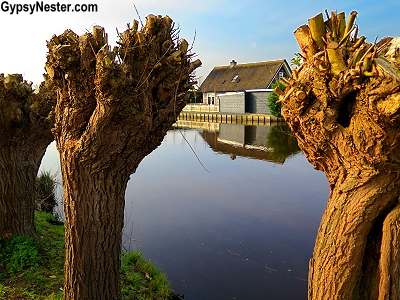
After making it to the top, he spotted a cradle floating in the distance and noticed an eerily coordinated cat jumping from side to side, balancing it against the waves.
When the cradle came closer, the man found a baby fast asleep — and perfectly dry inside.
The tale became famous as The Cat and the Cradle and the rest, as they say, is fake history (not sure if the legend inspired Harry Chapin’s famous comeuppance song, but we had it stuck in our heads all day, nonetheless).
The real origin of the name is a whole lot less inspiring:
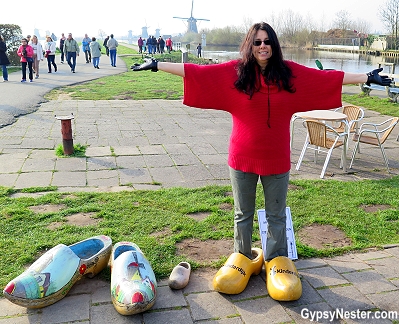
It is thought to relate to the child labor said to have been used in the construction of the dikes.
Yeah, we get why the cat story is more famous.
Whatever the truth behind the name, the fact is that the system holding back the water is an engineering marvel.
Over half of the Netherlands, which means low country, is below sea level, so pumping water is a never ending enterprise. The Dutch have been experts at controlling water for centuries, dating all the way back to the Middle Ages.
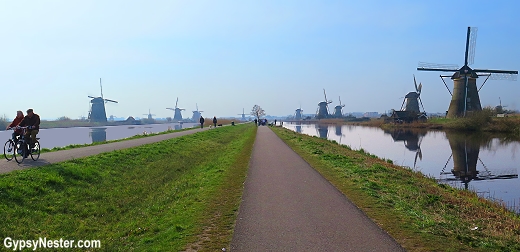
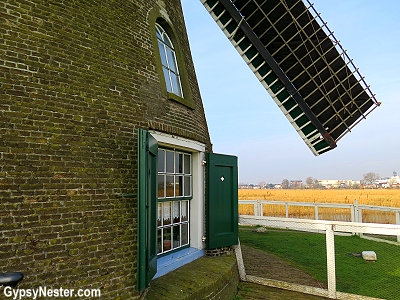
About a thousand years ago, people began building earthen dams and dykes to hold back water from low lying marshland.
But, alas, the barriers that created the dry land, known as polders, couldn’t do the entire job; water would still seep in through the ground.
That’s where the windmills came in, they were used to move water from low lying land up into the rivers, and finally out to the sea.
Yes, UP to the river!
Earlier in the day, from our balcony on the Longship Skadi, we felt the strange sensation of cruising on a river while looking down at all of the houses built below the water level.
How Windmills Work

We began our visit by learning about the mechanics of the mills at the little museum on site.
The design is fairly straightforward, but nonetheless ingenious.
Our guide, Kees, showed us how the wind turns the sail blades, which turn a set of large wooden gears that transfer the motion down a huge oak pillar, then, in turn, turns another wheel to scoop the water up and over the dike into a canal.
Through a series of these canals the water is finally lifted up the level of the river.
From the small museum we walked over to the modern pumping station that has replaced the old mills. Nowadays, several giant Archimedes’ screws do the job of removing the water from the lower ground and sending it on its way in a canal.
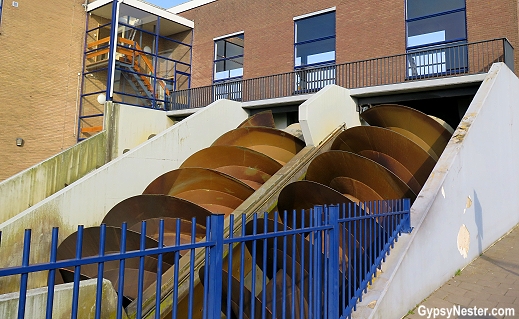

Armed with our rudimentary knowledge (enough to really cause trouble if we were somehow put in charge!), we headed inside one of the working windmills for a close up look at the inner workings.
Luckily, there was just enough of a breeze to fill the sails and turn the gears — but not enough to muss up our hair — so we got to see the huge shaft that runs down the center turning.
WATCH VIDEO!: Your GypsyNesters show you how windmills are done! People actually live in them!
Cramped Quarters: People actually live in windmills?
The mills also served as a home for the millers, the caretakers and operators that maintained the vital function of these flood-preventing workhorses. We entered and found rooms that circle around the mechanical assemblies like slices of pie.
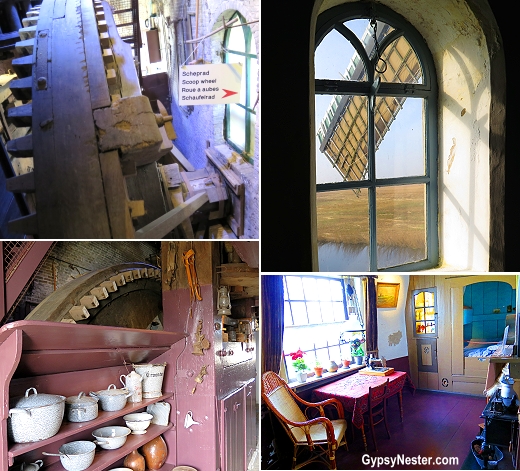
On the ground floor the kitchen and main living area fill most of the space, but there was quite a bit of room dedicated to storage and the operation of the pump too.
There was also a bed built into one wall, and we quickly came to see that sleeping space was definitely at a premium.

We climbed up a tiny staircase, actually more of a ladder, to the next level and found that the conical shape of the mill made for even smaller rooms up there.
The children had to pile into one tiny room together, no matter how many there were.
The one we went through was once home to a family with thirteen kids.
Ohhhh, maybe that‘s why this is called Kinderdijk.
David & Veronica, GypsyNester.com
See all of our adventures in Holland!
Thanks to Viking River Cruises for inviting us along and providing this adventure through the tulips and windmills of Holland and Belgium with stops in Amsterdam, Kinderdijk, Antwerp, Bruges, Veere, Hoorn, and Arnhem.
YOUR TURN:



I love the area and the tour guide was fabulous. I am also wondering about the children in the picture and wondering if they may have had a syndrome or medical condition?
I can’t imagine having that many children in such a small space.
It made us wonder too. Perhaps it was not as unusual years ago.
We visit a windmill in Bruges, very interesting.
Yes please! I would love to live in a windmill – it looks really interesting. And how interesting to learn that they are actually in use for a very important role.
Thanks for sharing.
Glad to Rebecca, it was very interesting.
I am embarrassed to admit that I had really no idea what they were used for! They are an iconic structure, but still no idea… I have only been to Amsterdam and LOVED IT. I want to go back and visit Kinderdijk. Great post!
Thanks Suzanne! There are many others in other places too.
I’m glad I’m not the only one who noticed the kiddie creep factor in the photo! Love windmills, and would have loved to live in one ever since I read a book about a family who did when I was in grade school.
Maybe they cut all of their hair off to keep lice away. Just a thought, but they do look weird.
Loved the story of the Kinderdijk windmills. 13 kids? There’s not a windmill big enough for me. 😀
We would have to agree.
Those windmills look so great. I’ve always wanted to get inside a windmill, although I cannot imagine a family with 13 children living in one. I keep coming across more reasons for a trip to Holland.
Holland is definitely worth a visit. Can’t even imagine how crowded that was though.
I’ve lived in the Netherlands for 18 years and still love an excuse to visit a windmill. Windmills were also used for other functions besides pumping water, like milling grain and producing oil from rapeseed. If your readers want to see more mills of different sorts, they could also visit Zaanse Schans, which has a whole, beautiful collection!
Thanks for the tip Rachel.
Is it my imagination or are almost all the kids in your last photo BALD? Or maybe just very blond… After meeting so many Dutch people when we were in Curacao this year we are eagerly looking forward to seeing this magical place for ourselves and I loved this post about the windmills in Kinderdijk. In addition to being necessary to preserving the landmass they’re so picturesque – I can easily imagine myself living in one (bald or not!)
Now that you mention it, they do look bald! No idea what that’s about, but it could just be the lighting in the photo I guess.
What a quaint village and wow So many windmills. I love the misty shot of the canal, the windmills and the bikes. Reminded me of our brief sojourn in Amsterdam.
Thanks Jo, it was very picturesque. Made it easy to get good shots.
I always wanted a treehouse, but after seeing the windmills, I might opt for one of those!
They are pretty cool, as long as you didn’t have 13 kids in there too.